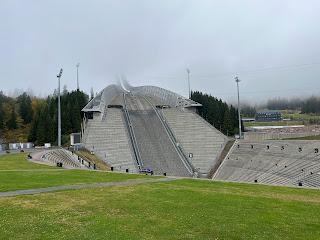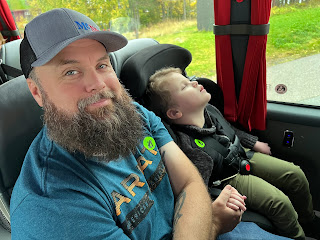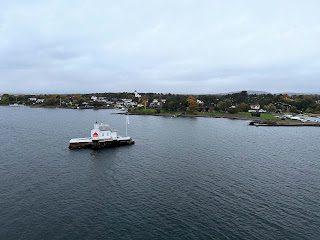Tuesday, October 4th:
We woke up to this beautiful view outside our windows! We are in Norway!
[Akershus Fortress - built in the 1290s]
As I was packing up Theo's backpack for the day I noticed that our fridge looked a little funny. Theo's medication and food seems a little out of place in our stocked fridge.
[Here we are!]
After breakfast we headed out to the dock to catch our tour bus. Our tour guide first took us on a driving tour through the city.
[Oslo Opera House]
[Oslo Cathedral]
[Foreign Affairs Ministry of Norway]
After driving through the city we made our way to the Bygdøy Peninsula. This beautiful area is know for its five museums (we get to visit two), hiking trails, forest, and beaches. The first museum we went to is the Norwegian Maritime Museum. We watched a short film about the history of Norway and the people's relationship with the sea.
We then went to a boat building workshop.
This is where the experimental archaeologist build ships in the exact same manor by which the Vikings did. They take their time, build the ships, and then they will test them out on the water.
We then learned about the Gokstad Ship Burial. Around 900 AD a chieftain was buried in a chamber in the aft of a 24 meter long Viking ship! He was buried with a variety of grave goods including three fast rowing boats, beds, tools, textiles, tens, 12 horses, and six dogs. It likely also contained weapons, gold, and silver, but those were likely looted from the site long ago. The ship burial was found officially in 1880 and is now in the Viking Ship Museum (which is closed until 2026 while they build a new museum). It remains the largest preserved Viking ship in Norway.
So, we didn't get to see the Gokstad Ship, but we did see one of the three fast rowing boats that were in the ship burial.
[Beautiful!]
We then walked through the museum and saw a variety of other Viking ships.
Next, we went to the Norwegian Museum of Cultural History. This open-air museum consists of 150 buildings that have been relocated here from rural areas.
The most famous building at this museum (and the reason why I wanted to go on this tour) is the Gol Stave Church.
Do you recognize it?! If you do it's likely because you've been to EPCOT!
This beautiful church was originally built in the late 12th century in Gol, but when a new church was built in 1880 the city decided to demolish this old church. It was saved and purchased by a preservation society and the King. The church was rebuilt here and restoration was finished in 1885.
The interior was very intricate and beautiful too!
[Altar and mural]
After seeing the church we continued our walk through the museum and saw more historic buildings from Hovin, Gransherad, and Telemark.
Even though the autumn in this part of Europe is not as extravagant as it is in parts of the US, the trees are still changing and I love the added colors.
[We were all freezing and Josh was super tough... as always!]
We had a few people in our group that walked with canes or walkers and one lady had a wheelchair. Her husband pushed her all around and he was amazing, but there was a pretty steep muddy hill that we had to walk up to get to the Gol Stave Church. Josh helped push the lady up the slope and then he walked her down. It was adorable! He's such a great guy ❤️
I love this old village with the beautiful buildings (the roofs!) and the intricate doors.
[Love the ivy]
We left the open air museum and drove up to Holmenkollen. As we wound our way up the mountain it got more and more foggy. By the time we got to the ski jump the clouds were so low that we couldn't see the top!
[Holmenkollen Ski Jump]
Aww! Theo doesn't hold hands too often, but when he does, it's usually with his dada 😍
We then drove up to the top of the ski jump where we saw the top of the ramp... almost.
We then headed all the way up to the top of the mountain to the Voksenåsen Hotel. We had a delicious lunch consisting of meatball (with gravy) and salmon! Gotta love those buffet's!
We came to this hotel because of the view. But instead of getting this:
We got this:
After lunch we found a nice large room with couches and laid Theo down for a quick nap. He's such a trooper.
After lunch we headed back down the mountain. When we came to the ski jump the bus driver pulled over quickly because we could actually see the whole thing!
The view on the way down was so much better due to the clouds lifting. We could see the Oslo fjord and all the small islands. It was beautiful!
We then ended our tour at the Vigeland Park (aka Frogner Park). Just a warning, this park contains 212 statues and 211 of them are completely naked. They aren't sexual, but I can understand that they may make some people uncomfortable.
The bus dropped us off on the northwest side of the park and our tour guide lead us toward the famous monolith. This park has the largest collection of sculptures by a single artist: Gustav Vigeland.
[Circle of Life]
[Compass]
[Gate to the Monolith]
There are statues leading up to the monolith. These statues at the bottom of the stairs depict old men and women and the statues closer to the monolith are children and babies.
[Babies]
[Family]
The monolith itself has older people at the bottom and younger kids at the top.
We left the monolith behind and headed down the stairs to the Fountain.
This Fountain has six large men (of various ages) holding up a large saucer.
We then walked through the garden and headed towards the Bridge.
[Always napping 😴]
I'm surprised there were still flowers out this late in the season! They were very beautiful!
The Bridge consists of 58 bronze statues which line both sides of the bridge.
The most famous statue on the Bridge is The Angry Boy.
[I just love him]
The only clothed statue in the entire park is a statue of the creator: Gustav Vigeland
After exploring the park we headed back to the ship. On the way we passed by the Bygdøy peninsula.
[Look at all those boats!]
[Boats with the Oscarshall on the Bygdøy peninsula]
We got back to the MS Rotterdam right before sunset. It was nice (and a little chilly) to stand out on our balcony as the ship sailed through the fjord.
[Oslo Opera House]
This lighthouse was built in 1874. It is now used as a venue for receptions and parties. How cool is that?!
[Heading out through the fjord]
I collect pins when I travel. I got the idea from my mom. I have a large cloth map that I display them on (my Aunt Janice Neilson made it for me) and I love it! Occasionally I will buy jewelry if it is a locally made significant piece. I feel like jewelry is a fun icebreaker:
"Oh wow! I love your ring!"
"Thanks! I got it in Oslo, Norway!"
This ring is forged iron and was locally made. Metalwork has been an important part of the Norwegian and Viking culture for a long time.
Oslo is the most northern port that we will be visiting on this cruise. Thank goodness because it was COLD today! Luckily, it only rained a little bit. Oslo is a beautiful city with such a rich history. Norway was my first Nordic country and I am excited to see a few others on this trip!























































































No comments:
Post a Comment